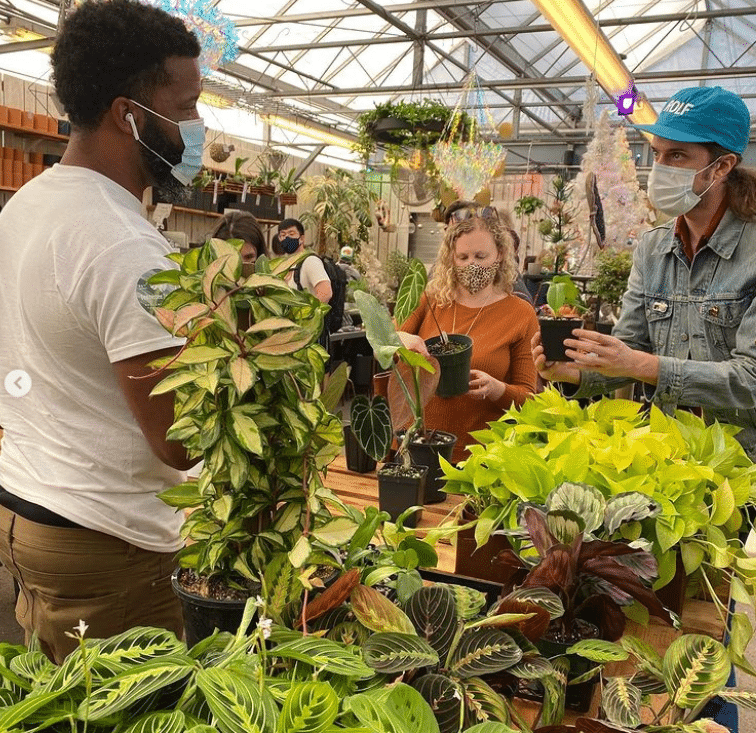
by Emily Vogler | Jul 10, 2022
July has plenty of challenges; protecting landscapes from intense heat, severe weather, and annoying pests – it’s not always an easy task! Here are some landscaping tips to keep in mind during July so that you can keep your yard thriving even during the most intense and unpredictable summer months:
- Spot spray any weeds, mow and water the lawn as needed; continue through the summer.
- Pay attention to the water needs of lawns, ornamental plants and vegetables, and especially new plants with undeveloped root systems and to outdoor potted plants, which can dry out quickly. Water in the early morning hours to minimize evaporation.
- Pay attention to the water needs of lawns, ornamental plants and vegetables, and especially new plants with undeveloped root systems and to outdoor potted plants, which can dry out quickly. Water in the early morning hours to minimize evaporation.
- Prune dead or broken branches of trees and shrubs; avoid major pruning during the heat of summer.
- Continue to check ornamentals, flowers, and vegetables for aphids and spider mites.
- Inspect broadleaf evergreen shrubs for scale insects, and treat as necessary.
- Watch for lace bugs on azaleas, pyracantha and lantana.
- Fertilize hanging baskets and other container plants regularly.
- To reduce mosquito pests, check house gutters and any containers for standing water.
To begin your next project, schedule a phone consultation!
If you would like to work with your existing designer, simply fill in their name in the “Project Details” section.

by Emily Vogler | Apr 19, 2022
There are 2 key parts to prepping you plants for spring: fertilization and acclimating plants to the outdoors.
Fertilization
- Start fertilizing houseplants about 8 weeks before the last expected spring frost. Here in Nashville, that’s mid-late April. The first few fertilizer applications should be made at half the recommended strength. Help acclimate your plant slowly to receive fertilizer again!
- Most houseplant fertilizers contain a mixture of both macro- and micronutrients.
- The three primary macronutrients, nitrogen, phosphorus, and potassium, found in a container of fertilizer are listed as a ratio on the front of the bottle or bag. Called the N-P-K ratio, these numbers tell you the percentage of each of those nutrients inside the container.
- Some of our favorite fertilizers are Monty’s All Purpose and Good Dirt Plant Food, These products are great for most general houseplant applications and can easily be diluted in a watering can. Feeding your plants will help you replace the minerals and nutrients that are lacking in your potting soil.
Acclimating
- When you take a plant from its indoor environment and place it outside suddenly, the plant can easily become stressed as a result of shock. Do this gradually, and your plants will love you for it!
- You shouldn’t place any houseplant in direct sunlight outdoors. Instead, seek out a nicely shaded area, perhaps your patio or under a tree, and allow your plants to take in the fresh air for a few hours each day. Then gradually move them to an area allowing a little sunshine and slowly increase their time outdoors, even leaving them out all day. After a couple weeks, the houseplants should be well adapted to their outdoor setting to remain throughout summer.
- Outside temperatures can vary greatly from indoors as well, and since the majority of houseplants originate from tropical-like regions, they cannot tolerate cold temperatures or anything below 55 F.
- You may also be dealing with pests. Inside, houseplants are not typically bothered by insects or other pests so much as they are outdoors. Become familiar with some of the more common insects pests so you’ll be better prepared at fighting them off.
- Bi-weekly preventative Neem oil applications will help deter any pests from making your plants a home.


by Emily Vogler | Nov 17, 2021
11.26 – 15% OFF Houseplants + First 100 customers receive 2″ poinsettia.
Plants are more than the sum of their leaves, stems, fronds, and roots. The simplicity, steady growth, and care you put in to your plants endear themselves to whomever they are given. Plants make great gifts! Share the love with 15% off houseplants on the 26th!
11.27 – TN Tropicals Pop-up
On November 27th from 10 am – 2 pm, Calvin of Tennessee Tropicals will have a pop-up set up at our garden center with tons of beautiful, rare tropical plants! He’s sure to have something to check off your plant wishlist or the perfect plant for your friend that has everything!

11.28 – Santa meet and greet + Shenanigoats
See Santa in the greenhouses on the 28th – he’ll be around from 10 am – 2 pm for pictures. And the Shenanigoats will be making an appearance from
10 am – 4 pm, too! An all-around wholesome day!

11.29 – Cyber Monday – 15% OFF ALL ONLINE Pottery! Upgrade your houseplants’ pots as a gift to yourself, or get a fancy pot for your friend! We have incredible options available online only!

11.30 – Giving Tuesday – we are taking donations for Launch Pad drop off at the store. Nashville LAUNCH PAD is a volunteer-based initiative striving to provide street-free sleep to displaced youths in Davidson Country between the ages of 18-24 with a focus on creating safe spaces that affirm the rights and dignity of LGBTQIA+ Youth.

by Emily Vogler | Aug 12, 2021
So, you’ve just purchased, or currently own, a Fiddle Leaf Fig. Now what? We get lots of questions about fiddle leaf figs on social media and in the nursery. In this video we’ll cover watering, lighting, maintenance, and fertilization! We’ll also talk a bit about common problems like leaf dropping and discoloration. Let’s get started!
Watering
The first thing we’re gonna talk about is watering. Fiddle Leaf Figs need to be thoroughly watered about once a week. Depending on the size of the plant — and therefore the size of the roots — you’ll want to adjust the amount you water. A good rule of thumb is to wait until the top 2 – 3 inches of the soil is dry, and then give the plant a thorough watering. You’ll want to make sure to plant in a planter with a drainage hole so you can thoroughly soak your plant until you notice water dripping out the bottom. However, don’t let the drip tray sit full of water for any extended lengths of time, as this allows root rot to set in easily.
Lighting
On to lighting tips – Fiddle Leaf Figs should be placed in front of a window that will receive direct morning or afternoon light. Ideally, what you’re aiming for is a window with a mostly unobstructed eastern, western, or southern exposure. Slowly acclimate to more sun, if they’re given too much direct sunlight too quickly, the leaves could burn and form brown scorch marks.
Maintenance
Next is maintenance – like with most other plants, Fiddle Leaf Figs do require some general maintenance. One important routine you can do for your Fiddle Leaf is dusting its leaves! Since their leaves are so large, Fiddle Leaf Figs need to be dusted regularly. When dust accumulates on plant leaves, dust particles make it difficult for the plant to absorb sunlight and perform photosynthesis. We also recommend using Leaf Shine to keep your plants’ leaves looking shiny and beautiful! In addition to dusting leaves, it’s also a good idea to rotate your plant weekly or bi-weekly. Rotating your plant gives it even light exposure, meaning one side won’t be growing drastically more than another, leading to a sturdy and symmetrical plant.
Fertilization
Fertilization is next, and our suggestion on fertilizing your Fiddle Leaf Fig is the ‘less is more’ approach. It’s best to not overwhelm your plants with additional nutrients all at once. We highly recommend using all purpose fertilizer like Monty’s twice a month during the spring and summer. Common problems and issues for fiddle leaf figs we usually see are things like leaf dropping & browning edges. It’s also worth mentioning that a humidifier can do wonders for Fiddle Leaf Figs and other tropical plants all year round, especially in the winter when indoor air becomes dry. They help to prevent browning leaf tips! Another important thing to remember is to make sure your Fiddle leaf fig isn’t getting any cold air from drafts by doors or air vents. This can cause leaves to drop.
I hope you got some good info on your fiddle leaf fig! If you’ve got any other questions we didn’t get to, you can text us at 615-244-8949 or visit our website!

by Emily Vogler | Jan 1, 2020
The Annual International Aroid Society Show is not a place to mess around – this event is filled with hard core plantaholics. Featured in an article from the New York Times, GOB Creative Director Trevor comments on the houseplant boom and the effects of social media on the plant game:
“Instagram has spawned a lot of people who are influencing people’s buying decisions on plants, so those plants become more scarce, and all of a sudden everyone needs one, then five, then 10, then a hundred,” said Trevor Bradshaw, 31, who works at a garden center in Nashville. “It’s crazy that you can convince someone to buy a living thing, like it’s a luxury item.” (Mr. Bradshaw said that he recently apprehended someone stealing variegated monstera cuttings from his store after they posted about the theft on Instagram.)”
We’ve seen a huge flux of new customers enjoying houseplants – more than ever! Several years ago, the Aroid Society, like some of its rarest specimens, appeared to be dwindling. The hobby had an arcane, almost Victorian dustiness to it, akin to collecting stamps or coins. “But in the past two or three years, said Alex Bello, 33, the president of the International Aroid Society and the chairman of the event, attendance has spiked from around 500 people in a weekend to a few thousand. “It has been exorbitant, the amount of people we’ve been getting,” he said. “We’ve been pummeled.” – the article mentions.
At Gardens of Babylon, we know that unique house plants, pottery, and garden accessories are essential to you. The problem is that high-quality products and plants are hard to find, which can leave you unsure how you can elevate your home or garden project to the next level. We believe you should be able to shop for unique plants with confidence and not stay stuck with cookie-cutter products that don’t meet your standards. We offer high-quality, sustainable, and eco-friendly products. We care for the environment, and our competent team members are ready to point you to just the right product for your project!
Check out some of the five-star Google reviews we’ve received about our outstanding garden center:
“As a houseplant enthusiast, I’ve heard legends of this place, and it was even better than I’ve heard!! So many rare plants all in one place, definitely more expensive than some other places but it’s clearly worth the money for the convenience! Their staff was helpful and friendly, while giving us plenty of space to browse on our own. They have such a wide selection of all plant care needs, indoors and out. I also loved the living wall, and they had a great selection of unique pots!” – Jess
“Super stunning variety of plants with friendly and helpful service! The Gardens of Babylon are a must see even if you’re not looking to take any plants home. They have a massive variety, and everything is organized very nicely. My friend got some very nice string of pearls plants from here that are healthy and bug free AND very reasonably priced! Plus, the people who work here are knowledgeable about plants so feel free to ask any questions pre-purchase if you’re not sure how to take care of your desired plant :)” – Madelyn










